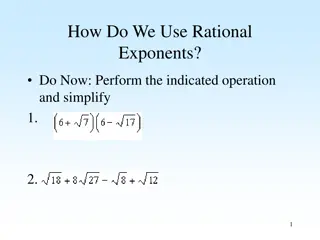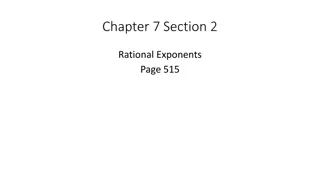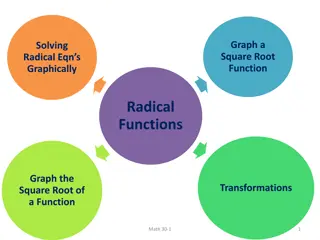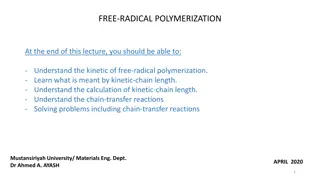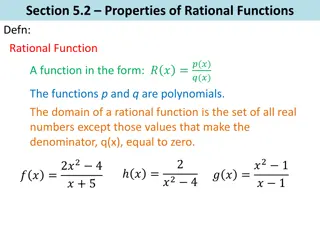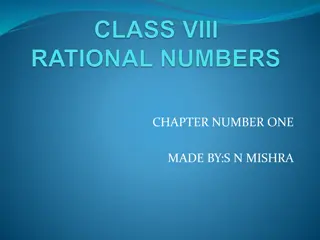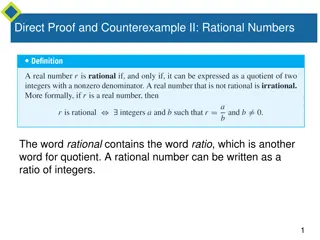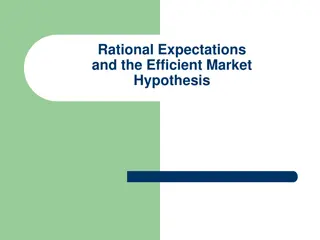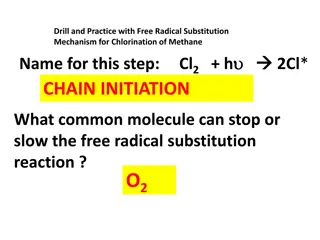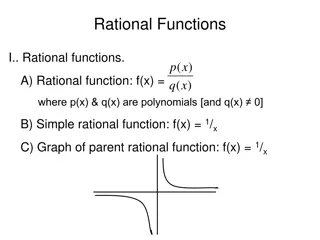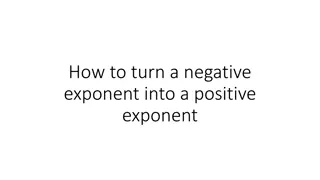Rational Exponents and Radical Functions
In this chapter of Algebra 2, you will explore rational exponents and radical functions. Learn how to evaluate nth roots, use rational exponents, find roots manually, and utilize calculators effectively. Dive into properties of rational exponents to enhance your understanding of algebraic concepts.
Download Presentation

Please find below an Image/Link to download the presentation.
The content on the website is provided AS IS for your information and personal use only. It may not be sold, licensed, or shared on other websites without obtaining consent from the author.If you encounter any issues during the download, it is possible that the publisher has removed the file from their server.
You are allowed to download the files provided on this website for personal or commercial use, subject to the condition that they are used lawfully. All files are the property of their respective owners.
The content on the website is provided AS IS for your information and personal use only. It may not be sold, licensed, or shared on other websites without obtaining consent from the author.
E N D
Presentation Transcript
R A T IO N A L E X P O N E N T S A N D R A D IC A L F U N C T IO N S Algebra 2 Chapter 6
This Slideshow was developed to accompany the textbook Larson Algebra 2 By Larson, R., Boswell, L., Kanold, T. D., & Stiff, L. 2011 Holt McDougal Some examples and diagrams are taken from the textbook. Slides created by Richard Wright, Andrews Academy rwright@andrews.edu
6 .1 E valuate nth R oots and U se R ational E xponents Root If a2 = b, then a is a square (2nd) root of b If an = b, then a is the nth root of b Parts of a radical Radical Sign 364 Index Radicand
6 .1 E valuate nth R oots and U se R ational E xponents Rational Exponents ? ? 1?= ?? ??= ???= ?? ? Evaluate 36 12
6 .1 E valuate nth R oots and U se R ational E xponents 1 3 1 8 4 3 27
6 .1 E valuate nth R oots and U se R ational E xponents To find the roots by hand Find the prime factorization of the radicand Group the prime factors into groups of the same factor. Each group should have as many factors as the index. For each complete group, you can move that factor out of the radical once (the group becomes one number) If the index is even and the radicand is negative, the roots are not real
6 .1 E valuate nth R oots and U se R ational E xponents 364 36?4
6 .1 E valuate nth R oots and U se R ational E xponents Find roots with a calculator The ? or key is for square roots (either radicand then key or key then radicand depending on calculator) The ?? or is for any root (index key radicand OR radicand key index) Try it with ? ?? or 4100
6 .2 A pply P roperties of R ational E xponents Using Properties of Rational Exponents ?? ??= ??+? ???= ???? ?? ?= ??? ?? ??= ?? ? ? ? ? ?= ? =?? ?? 1 ??
6 .2 A pply P roperties of R ational E xponents 61/2 61/3 (271/3 61/4)2
6 .2 A pply P roperties of R ational E xponents (43 w3)-1/3 ? 3 4 ?
6 .2 A pply P roperties of R ational E xponents Using Properties of Radicals Product Property ?? ? = ?? ?? Quotient Property ?? ?? ? ? ?=
6 .2 A pply P roperties of R ational E xponents 332? 34? 325 35
6 .2 A pply P roperties of R ational E xponents Writing Radicals in Simplest Form Remove any perfect roots Rationalize denominators 464 (16g4h2)1/2
6 .2 A pply P roperties of R ational E xponents 2 3 5 ?5 ?8 18?? 1 4? 3 6?
6 .2 A pply P roperties of R ational E xponents Adding and Subtracting Roots and Radicals Simplify the radicals Combine like terms 5(43/4) - 3(43/4)
6 .2 A pply P roperties of R ational E xponents 381 33 46?5+ ? 46? 2
6 .3 P erform F unction O perations and C omposition Sometimes for your problems you need to repeat several calculations over and over again (think science class). It would be quicker to combine all the equations that you are using into one equation first, so that you only have to do one equation each time instead of many.
6 .3 P erform F unction O perations and C omposition Ways to combine functions Addition: (f + g)(x) = f(x) + g(x) Subtraction: (f g)(x) = f(x) g(x) (f g)(x) = f(x) g(x) Multiplication: Division: (f/g)(x) = f(x) / g(x)
6 .3 P erform F unction O perations and C omposition Given f(x) = 2x1/2 1 and g(x) = x1/2 find (f + g)(x) (f - g)(x) (f g)(x) (f / g)(x)
6 .3 P erform F unction O perations and C omposition Composition Put one function into the other. (Like substitution) Written f(g(x)) Said f of g of x Means that the output (range) of g is the input (domain) of f. Work from the inside out. Do g(x) first then f(x). g(x) gets substituted into f(x)
6 .3 P erform F unction O perations and C omposition Find f(g(x)) when f(x) = 2x + 3 and g(x) = x2 Find g(g(x))
6 .4 U se Inverse F unctions Sometimes you want to do the opposite operation that a given function or equation gives you. To do the opposite, or undo, the operation you need the inverse function.
6 .4 U se Inverse F unctions Properties of Inverses x and y values are switched graph is reflected over the line y = x You can use the Horizontal Line test to determine if the inverse of a function is also a function. If a horizontal line can touch a graph more than once, then the inverse is not a function.
6 .4 U se Inverse F unctions Definition of inverses Two functions are inverses if and only if f(g(x)) = x and g(f(x)) = x Remember a function is when one x value only goes to one y value (lines are functions, quadratics are functions, square roots are not functions)
6 .4 U se Inverse F unctions Verify that f(x) = 6 2x and g(x) = 6 ? 2 are inverses.
6 .4 U se Inverse F unctions Finding inverses Inverses switch the x and y coordinates Switch x and y and solve for y. ? = 2? + 7
6 .4 U se Inverse F unctions Finding inverses If the function is written as an expression ? ? = ?4+ 2,? 0 ? = ?4+ 2,? 0 Rewrite f(x) as y (if problem is y=___, skip 1st and last step) Switch the x and y Solve for y Rewrite y as f-1(x) ? = ?4+ 2,? 0 ? 2 = ?4,? 0 ? = ? 1? = 4? 2,? 0 4? 2
6 .5 G raph S quare R oot and C ube R oot F unctions ? = ? 3? ? = domain x 0 range y 0 Domain: all real numbers Range: all real numbers
6 .5 G raph S quare R oot and C ube R oot F unctions How graphs transform ? = ? ? + ? 3? + ? ? = ? Graphing shortcut 1. Start with the points from ? = 2. Multiply the y-coordinates by a 3. Move over h to the right and up k ? or ? = 3?
6 .5 G raph S quare R oot and C ube R oot F unctions How did the following graphs transform? ? = ? 3 + 4 3? + 3 5 ? =
6 .5 G raph S quare R oot and C ube R oot F unctions Graph ? = 2 3? 3 + 1
6 .5 G raph S quare R oot and C ube R oot F unctions Find the domain and range ? = 2 ? + 4 1 3? 5 + 6 ? = 3
6 .6 S olve R adical E quations Radical Equation Equation containing a radical Steps 1. 2. Isolate the radical Raise both sides to whatever the index is (or the reciprocal of the exponent) Solve Check your answers!!! 3. 4.
6 .6 S olve R adical E quations 5 4? = 0 4 3= 243 3?
6 .6 S olve R adical E quations 2? + 8 4 = 6 4? + 28 3 2? = 0
6 .6 S olve R adical E quations ? + 2 = 2? + 28 Check!


